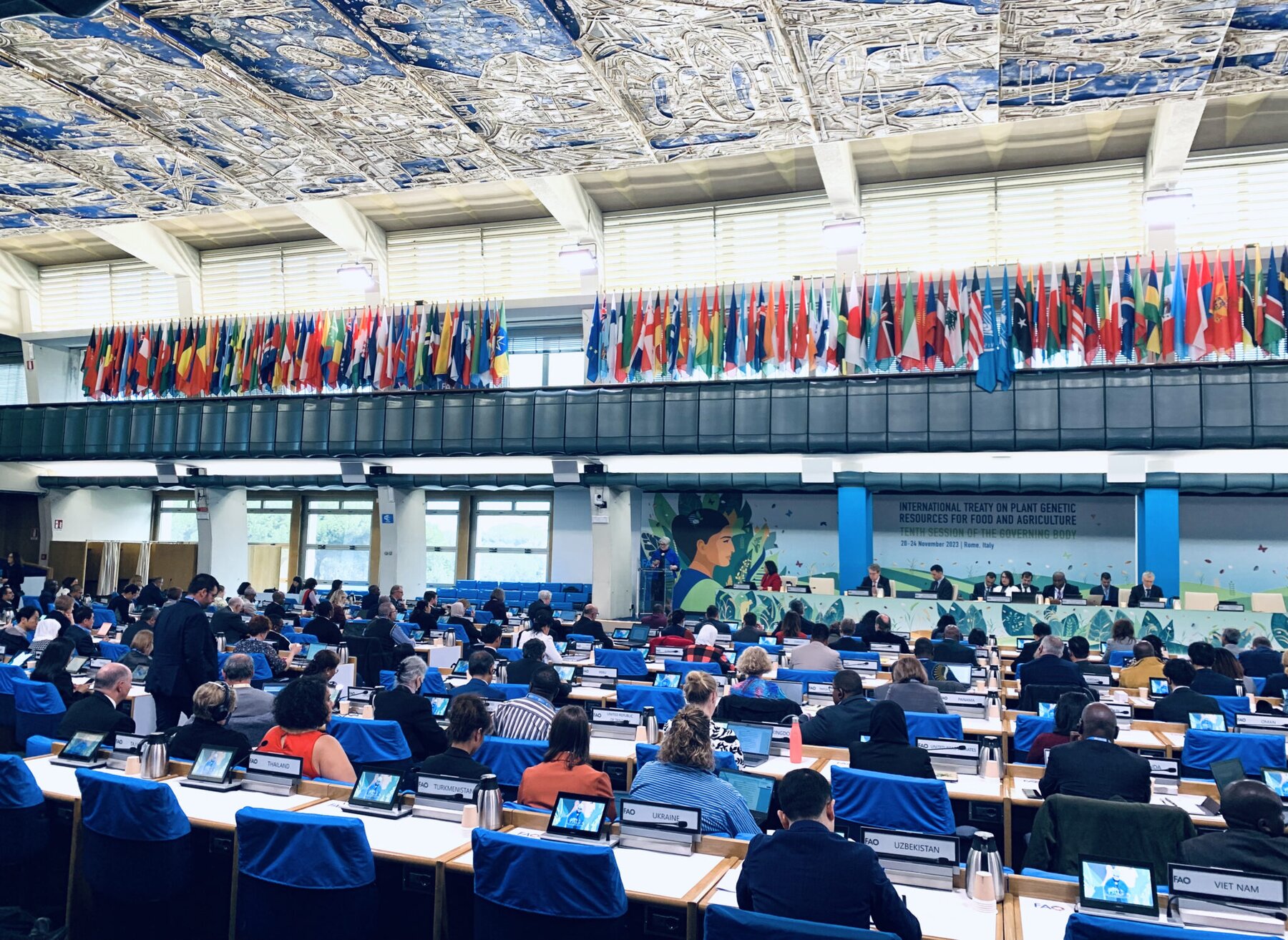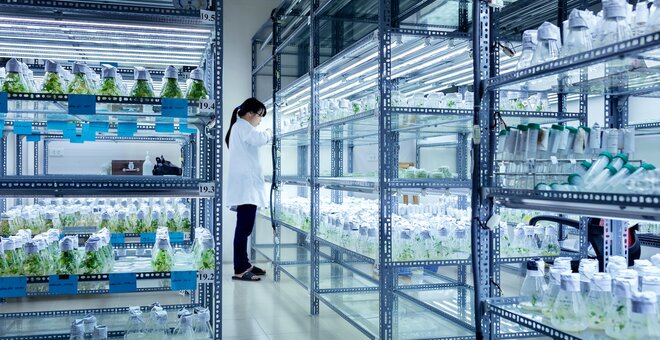The International Plant Treaty
The Crop Trust is recognized as an essential element of the funding strategy of the International Treaty on Plant Genetic Resources for Food and Agriculture (International Plant Treaty).
The International Plant Treaty is the major international agreement between member countries to conserve, use and manage plant genetic resources for food and agriculture around the world for the benefit of people everywhere. It ensures that farmers and plant breeders access, easily, the plant genetic material needed to develop new crop varieties, including those with higher yields and those that are resilient to climate change.
It provides a global solution to the challenges of crop diversity loss and climate change adaptation through mechanisms such as the Multilateral System and Benefit-sharing Fund. To date, its Multilateral System on Access and Benefit-sharing covers 64 of the world’s major crops, accounting for about 80% of our food derived from plants.
The genetic resources of our most important food crops – the “life insurance policy” for our food production – are managed and exchanged by member countries and other stakeholders according to the provisions of the International Plant Treaty.
The International Plant Treaty was adopted by the Thirty-First Session of the Conference of the Food and Agriculture Organization of the United Nations on 3 November 2001.
A Global System for a Global Good
Specifically, the International Plant Treaty declared that 64 of our most important crops would be brought into one multilateral system, along with many of their wild relatives. All contracting parties would make their collections of this diversity available to everyone.
Making Crop Diversity Available to All
Under the International Plant Treaty, breeders can easily obtain and work with the material of these crop families from more than 150 countries. In many cases, they will do something innovative with it, such as create a new variety by combining lines from different parts of the world. Anyone who does so agrees that they will, in turn, make the derived variety freely available – or if they use it to develop a commercial product, that they will pay a percentage of profits into a special benefit-sharing fund.
The Crop Trust and the International Plant Treaty
A relationship agreement between the Governing Body of the International Plant Treaty and the Crop Trust was approved at the Governing Body’s first meeting in 2006.
This agreement recognized the Crop Trust as an essential element of the funding strategy of the Treaty. It also established four seats on the Crop Trust’s Executive Board to be appointed by the Governing Body, while confirming the Board’s executive independence in managing the operations and activities of the Crop Trust.
In 2021, the Crop Trust and the International Plant Treaty together launched an Emergency Reserve to provide a financial lifeline to genebanks facing urgent threats to their precious contents. The Reserve, which is the first of its kind, will respond to urgent requests from genebanks in low- and middle-income countries to prevent catastrophic loss of their collections.
Two Funds to Keep Seeds Available, Accessible and Secure
The diversity of crops we rely on every day, such as rice, wheat, potatoes, beans and more, is under threat. But thanks to international collaboration, vital efforts are underway to conserve and share this diversity across borders and generations.
Explore how the International Plant Treaty, its Benefit-sharing Fund, and the Crop Trust’s Endowment Fund work together to keep seeds flowing and crop diversity thriving for today’s farmers and tomorrow’s food security.
Frequently Asked Questions
These questions and answers are abridged from an interview
“The International Plant Treaty: Q&A with Crop Trust Director of Science, Luigi Guarino”
What is the International Treaty on Plant Genetic Resources for Food and Agriculture?
The International Plant Treaty, or Seed Treaty, as it is sometimes known, aims to improve global food security by making it easier for scientists and farmers to obtain and use seeds and other plant material for crop improvement, research, and training. It was adopted by the Food and Agriculture Organization of the United Nations (FAO) in 2001 after many years of negotiations and came into force in 2004. As of April 2025, there are 154 contracting parties – 153 countries, plus the European Union.
What do Parties to the Treaty commit to?
Among other things, they commit to sharing plant material of 64 globally important food and forage crops that is under the management and control of the national governments and in the public domain, following agreed rules. These crops are listed in Annex 1 of the Treaty. The rules ensure requesters can obtain the material and that, where appropriate, they share a portion of any monetary benefits arising from their use of it. This is referred to as the “Multilateral System of Access and Benefit-Sharing''.
Which crops are included in the 64 Crops [in Annex 1]?
Lots of our favorites, like rice, wheat, maize, potato, oat, coconut, banana, millet, yam, carrot, strawberry, and so on.
Why doesn’t Annex 1 cover all food crops?
Because everything in the Treaty was the subject of intense international negotiations among countries. Not all countries agreed to certain crops being included, so some had to be left out.
Why is it important to have a Multilateral System?
Breeders and researchers typically need material from many different sources to get as much crop diversity into their programs as possible. This gives them a better chance of developing new crop varieties that can eventually benefit farmers and consumers. Before the Treaty, they would have had to make separate, bilateral deals with different providers to get those different samples. All that takes time and money… A system like this significantly speeds up the exchange of plant material, helping scientists and farmers make use of it more readily.
So can anyone, anywhere request plant material from a genebank?
Yes, as long as the provider is in one of the 154 contracting parties to the International Plant Treaty. The requester would need to sign something called a Standard Material Transfer Agreement, or SMTA. This ensures requesters abide by the rules set out in the International Plant Treaty, including paying a portion of the monetary benefits arising from their use of that material.
What is the role of the Crop Trust in all this?
For the Multilateral System to work effectively, genebanks need stable, long-term funding. The International Plant Treaty recognizes the Crop Trust as essential to this, by virtue of its Crop Diversity Endowment Fund. This fund, made up of donations from governments, and to a lesser extent, the private sector, accrues interest, which is then used to support genebanks around the world.
In particular, the Crop Trust has committed to supporting the international genebanks recognized under Article 15 of the Treaty as well as the ultimate failsafe for the whole system, the Svalbard Global Seed Vault.
The Crop Trust’s shorter-term projects also further the aims of the Treaty, for example by enhancing crop conservation at the national level through support for seed regeneration (growing plants to replenish or increase seed stocks for conservation), duplication of seeds so they can be safely backed up, collecting crop wild relatives to increase available genetic diversity for crop breeding, and more.
Related Crop Trust News
Crop Trust and Plant Treaty pledging more than $100,000 to safeguard crucial genebanks in Laos and Sudan
Rome, Italy, 20 November, 2023: In the face of conflict and extreme weather, the Crop Trust and the International Treaty on Plant Genetic Resources for Food and Agriculture (Plant Treaty) have pledged more than $100,000 (USD) to...
20 Nov 2023
Crop Trust and the Plant Treaty Launch Lifeline for Genebanks to Secure the Future of Crop Diversity
Climate change, the global pandemic, pest and pathogen outbreaks, and political instability are posing ever-increasing threats to genebanks around the world In response, the Crop Trust and the Secretariat of the International...
6 Nov 2021
6 Nov 2021
Hope for Multilateralism Yet
Luigi Guarino | Director of Science
I think it’s fair to say that things have not been going very well for multilateralism lately. Quite apart from what’s been happening in politics around the world, but possibly connected to it,...
10 Dec 2020
10 Dec 2020




